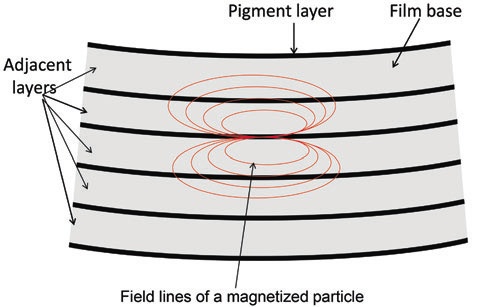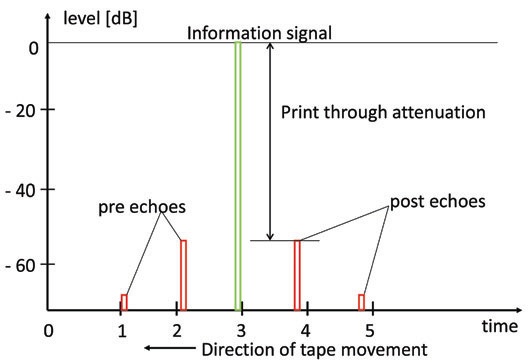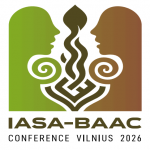3.7.2 Sources of stray magnetic fields
AC fields are typically produced by ACpowered motors and by transformers. AC power lines do not exhibit significant external fields as long as conductors are close together (which is normally the case). DC fields are radiated by permanent magnets. In contrast to some fears, the magnetic field of the earth is too weak to influence magnetic recordings.
3.7.2.1 Typical threats in audiovisual archives. The most dangerous sources of stray magnetic fields typically used in audiovisual archives are dynamic microphones, dynamic headphones, loudspeakers, and moving coil instruments (level meters). As the field strength falls exponentially with distance, even the strongest fields produced by these gadgets are, at a distance of 15 cm to recorded tapes, well below the above-mentioned DC threshold. Finally, bulk erasers, as used to erase analogue audio and video tapes, have extremely strong magnetic fields and must not be employed in areas where recorded tapes are handled or stored. When separating such devices from handling and storage areas, it must be kept in mind that normal walls do not shield magnetic fields. For risks associated with transport see 4.8.
3.7.2.1.1 De-magnetization of replay equipment (“de-gaussing”). In order to prevent negative influences on recorded tapes, all metal tape guides and heads must be demagnetised at regular intervals (daily, or every 10 hours of use). DC magnetic fields decrease S/N ratio and may increase non-linear distortions. To avoid inadvertent magnetisation, magnetic screwdrivers and other tools must never be used for maintenance of magnetic tape replay equipment. Also, head blocks must only be changed after machines have been switched-off.
3.7.2.2 General threats. Magnetic door shutters of cabinets and magnetic board stickers must be absolutely avoided, as their inadvertent immediate contact with magnetic tape will be harmful. Electromagnetic door holders used for fire divisions should be checked for their field strengths. Electrical motors driving mobile shelves and conveyor belts should be checked, as well as motors of vacuum cleaners used in storage areas. Electric welding must not take place in the presence of magnetic carriers: a distance of one metre minimum should be observed. It is also advisable to check the immediate vicinity around storage areas, as walls do not protect from stray magnetic fields. House transformers or motors of elevators may be immediately adjacent to outside walls and remain unnoticed, especially if they are in neighbouring buildings. For magnetic tape transport see 4.8.3.
3.7.2.3 Metal stacks. In contrast to many fears of the 1950s, metal stacks are normally not dangerous for storing magnetic recordings. Care must be taken to prevent stacks inadvertently becoming part of the lightning conductor system in the event of a strike (3.7.2.4.1). Therefore, the grounding (earthing) of metal stacks, as widely required by general safety regulations, should be critically discussed with specialists. It is very unlikely that magnetic shelves will have a permanent magnetic field. If a shelf does, it probably originates from the use of pick-up magnets during manufacture.19
3.7.2.4 Electromagnetic pulses (EMPs) are single, extremely short, highly energetic broadband bursts of electromagnetic radiation. Although the electromagnetic field of an EMP exists for an extremely short time only, it may be very strong, endangering data carriers in two ways: magnetic carriers may be reoriented and thus have their information erased, while solid state carriers may be destroyed by the high voltages the strong magnetic fields may induce. Apart from data carriers, strong artificial EMPs are a particular concern because of their destructive potential to electronic hardware, electrical installations and, through fire, to entire buildings. Since electromagnetic fields spread with the speed of light, no warning is possible.
There are several forms of natural and artificial, man-made EMPs. In audiovisual preservation, only three forms are of particular interest: lightning, other electrostatic discharges, and EMPs as a result of a nuclear explosion.
3.7.2.4.1 Lightning. Although no damage by lightning conductors in the course of a strike has ever been reported, it is not unlikely this has happened unnoticed in some cases. The magnetic field emitted by a lightning conductor in the event of a strike is dependent on the current the strike generates and the distance from the conductor. Strikes in moderate climatic zones have an average current of around 25–30 kA.20 In tropical areas, however, strikes up to 400 kA have been measured. While for 60 kA a distance of about 5 m is sufficient to diminish the field to the threshold of 25 Oe, the distance needed for a tropical 400 kA strike would be about 33 m. In a properly designed lightning conductor system, however, the strike is diverted to several, separate vertical conductors, each taking a part of the total current. This, in practice, reduces the required safety distance between the lightning conductor and magnetic carriers. All must be done to prevent metal stacks or the plumbing, central heating, etc, to become part of the lightning conducting system in the event of a strike (3.7.2.3). The design of lightning protection should comply with IEC 1024-1.
This potential threat is a generally underrated factor in audiovisual preservation, but should receive careful consideration when reviewing archive safety, or when designing new constructions.
3.7.2.4.2 Other electrostatic discharges (ESD). Insulating material can become electrostatically charged by frictional electricity. For example, human bodies may be charged up to 30 kV after walking over a well-insulated carpet, in particular at very low relative humidity. When touching any conducting objects, a discharge through a little spark happens that creates a very short and high EMP which may result in damaging or even destroying susceptible electronic components—another reason, in addition to dust prevention, to ban carpets from audiovisual archives.
Another effect originates from electrostatically charged discs and magnetic tapes, predominantly those made from PVC. In their replay, electrostatic discharges become audible as clicks both on the output of the machine and acoustically in the room. Such discharges do not damage the carriers, but their annoying influence on the replay must be avoided by discharging carriers before or during replay.
3.7.2.4.3 Artificial EMP. For audiovisual preservation, the most relevant artificial EMP would be the one produced by a nuclear weapon (NEMP). The strength of its magnetic field would depend on various factors (force of detonation, design of the weapon, altitude of explosion), possibly strong enough to erase unshielded magnetic recordings, but also indirectly dangerous by destroying electronic hardware, electric installation and construction through fires caused by high voltages induced in metal conductors.
3.7.2.4.4 Protection against EMP. Although, theoretically, audiovisual archives may be considerably endangered by NEMPs, their probability is, however, extremely low. Protection against EMP for equipment and magnetic carriers can be provided by enclosing them in a Faraday cage and by using appropriate protection circuits (galvanic separation, excess voltage diverters) on all power lines. Buildings and single rooms can be protected by completely covering with earthed, metal wire netting.
Generally, the higher the frequency of the electromagnetic radiation, the smaller the meshes of the wire netting must be. As the spectrum of pulses—theoretically—is indefinite, effective shielding will require a completely sealed, highly conductive metal sheet, e.g. copper, which is well grounded.
3.7.2.5 Print-through is the unintended copying of signals to adjacent layers in the magnetic tape pack. The problem arises because of an uneven spread of coercivity across the particles of a given tape: While high coercivity particles resist re-orientation caused by the magnetic fields of the adjacent layer, a small percentage of low coercivity particles is susceptible to re-orientation. Print-through occurs immediately after recording with the first contact of two layers on the wind-up spool and increases logarithmically with time.21 Apart from the general susceptibility of a given magnetic layer, the level of print-through is also dependent on the thickness of the tape.22 The steepness of the increase in level rises with temperature and is also furthered by the presence of low external magnetic fields.
With the international “oxide in” winding standard, the print is stronger on the outer than on the inner layer of the nourishing signal. When the tapes are stored on the supply reel, the “unnatural” pre-echo is stronger than the less disturbing post-echo. Therefore, “tails-out” storage has gained wide popularity. With German “oxide-out” storage standard (“B-wind”), the opposite applies.
Because print-through is caused by unstable, low coercivity particles, it can be removed to a great extent by winding the tape in the fast-winding mode several times before replay. This makes use of the magnetostrictive effect on low coercivity particles.23
To minimise print-through for further replay, replayed tapes should be brought to storage temperature and then rewound several times to keep the initial print-through level to a minimum.
It must be remembered that any failure to minimise print-through before transfer will make the printed signal part of the new recording.

Figure 28: Mutual interference of adjacent magnetic layers.

Figure 29: Pre and post echoes.
19. Systematic measurements of metal shelves have shown permanent DC fields in the order of up to 1 Oe. It may be advisable to specify that level as maximal permissible when ordering steel shelves, and measure at delivery.
20. In Austria, for example, average lightning strikes do not exceed 30 kA. Therefore, lightning conductors are specified to withstand a strike of 60 kA.
21. Its increase in the first time unit is the same of that of the next ten and then hundred (or any other exponential series of) time units.
22. Because of its wavelength-to-tape thickness ratio, and because of optimal signal perception in the low-mid frequency range around 1000 Hz, the subjective annoyance also depends on the speed of recording. Thus, print-through is significantly more annoying on a 38 cm/s recording on standard play tape than, e.g. on a compact cassette with its low recording speed of 4.76 cm/s.
23. With most tapes, a print-through built up within 224 days could be reduced below the 24 hour level by fast winding the tape three times (Schüller 1980).


